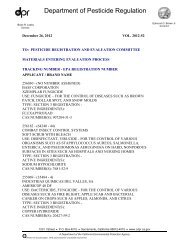Environmental Fate of Imidacloprid - California Department of ...
Environmental Fate of Imidacloprid - California Department of ...
Environmental Fate of Imidacloprid - California Department of ...
You also want an ePaper? Increase the reach of your titles
YUMPU automatically turns print PDFs into web optimized ePapers that Google loves.
<strong>Environmental</strong> <strong>Fate</strong><br />
The low Koc <strong>of</strong> 132 to 310, combined with a high water solubility <strong>of</strong> 514 ppm, suggests<br />
a potential to leach to ground water, although earlier field studies, under normal weather<br />
conditions, have found imidacloprid to be relatively immobile in silt loam soils<br />
(Rouchaud et al., 1994; Miles Inc., 1993). The moderate Kow value <strong>of</strong> 3.7, combined<br />
with its rapid photodegradation in water, (half-life (t1/2) < 3 hours) and on soil (t1/2 39<br />
days), suggests a low potential for bioaccumulation (DPR Pestchem Database, 1995).<br />
Air: Some formulations <strong>of</strong> this pesticide are applied by spraying in an upward<br />
direction allowing for possible <strong>of</strong>fsite movement through drift. The low vapor pressure<br />
<strong>of</strong> 1.0 x 10 -7 mm Hg indicates that this insecticide is relatively non-volatile. Since,<br />
imidacloprid also has a low soil adsorption coefficient, it has a relatively low potential<br />
to be dispersed in air over a large area via air-borne soil particles. The low Henry's law<br />
constant <strong>of</strong> 6.5 x 10 -11 atm m 3 /mole also indicates that it has low potential <strong>of</strong> volatizing<br />
from water.<br />
Water: There is a potential for imidacloprid to enter streams and ponds via drift during<br />
application or in run<strong>of</strong>f water. Rouchaud et al. (1994) and Miles Inc. (1993) found that<br />
imidacloprid did not leach to ground water in their field studies. But in a recent study<br />
conducted in 1997 to 1998, Bayer Corporation found imidacloprid in ground water, 18<br />
feet below ground surface (sandy loam soil). Concentrations ranged from < .1 ppb to 1<br />
ppb.<br />
Hydrolysis <strong>of</strong> this pesticide is greater than 30 days at pH 7 and 25 o C. Sarkar et al.,<br />
(1999) reported that the hydrolysis half-life varies from 33 to 44 days at the same pH<br />
and temperature. <strong>Imidacloprid</strong> was found to be stable in acidic and neutral water, but<br />
more readily hydrolyzed in alkaline water (Zheng et al., 1999).<br />
The formulation <strong>of</strong> the insecticide can affect the half-life. In wetable powder<br />
formulations persistence increased by 3 to 6 days compared to liquid formulations<br />
(Sarkar et al., 1999).<br />
Mobay (1989) found the two major metabolites via hydrolysis were 1-[(6-chloro-<br />
3pyridinyl)methyl]-4,5-dihydro-1H-imidazol-2-amine] (imidacloprid-guanidine) and 6chloro-3-pyridyl-methylethylendiamine.<br />
Zheng et al. (1999) found the only main<br />
metabolite was 1-[(6-chloro-3pyridinyl)methyl]-2-imidazolidone.<br />
The aqueous photolysis half-life is less than 3 hours (Wamh<strong>of</strong>f et al., 1999; Moza,<br />
1998). The prime degradation products resulting from photolysis in water were found<br />
to be:<br />
• 1-[(6-chloro-3-pyridinyl)methyl]-2-imidazolidinoe (imidacloprid urea)<br />
• 6-Chloro-nicotinaldehyde<br />
• N-methylnicotinacidamide<br />
• 6-chloro-3-pyridyl-methylethylendiamine
















